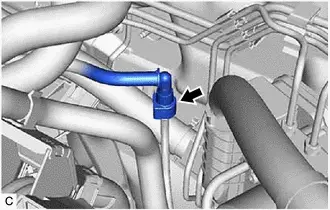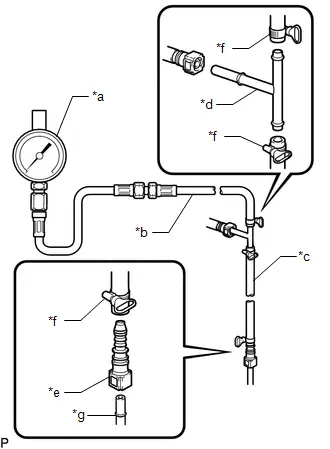Toyota Prius: Fuel System
Precaution
PRECAUTION
CAUTION:
-
Never perform work on fuel system components near any possible ignition sources.
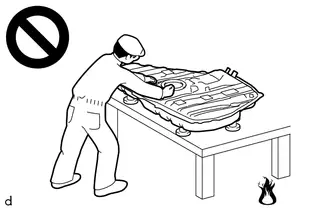
- Vaporized fuel could ignite, resulting in a serious accident.
-
Do not perform work on fuel system components without first disconnecting the cable from the negative (-) auxiliary battery terminal.
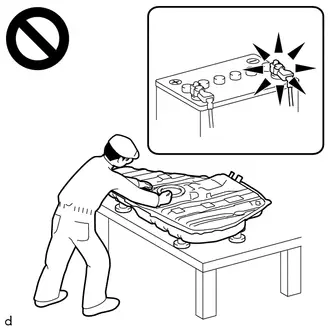
- Sparks could cause vaporized fuel to ignite, resulting in a serious accident.
-
The fuel tank sub-assembly is very heavy. Be sure to follow the procedure described in the repair manual, or the fuel tank sub-assembly may fall off the engine lifter.
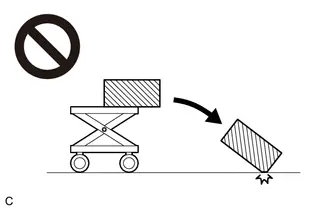
BEFORE WORKING ON FUEL SYSTEM
(a) Before inspecting and repairing the fuel system, disconnect the cable from the negative (-) auxiliary battery terminal.
Click here

(b) Do not smoke or work near fire when handling the fuel system.
(c) Keep fuel away from rubber or leather parts.
DISCHARGE FUEL SYSTEM PRESSURE
CAUTION:
- Make sure the engine coolant temperature is 60°C (140°F) or less when performing this procedure.
- Do not disconnect any part of the fuel system until you have discharged the fuel system pressure.
- Pressure will still remain in the fuel lines even after performing the following procedure. When disconnecting a fuel line, cover it with a piece of cloth to prevent fuel from spraying or coming out.
(a) When discharging fuel system pressure by disconnecting the C/OPN relay:
(1) Remove the No. 2 relay block cover.
(2) Remove the C/OPN relay.
(3) Put the engine in Inspection Mode (Maintenance Mode).
Powertrain > Hybrid Control > Utility| Tester Display |
|---|
| Inspection Mode |
(4) Start the engine. After the engine has stopped on its own, turn the ignition switch off.
NOTICE:
Do not increase the engine speed or drive the Toyota Prius vehicle while waiting for the engine to stop on its own.
(5) Crank the engine again and make sure that the engine does not start.
HINT:
DTC P017100 (System Too Lean Bank 1), P017200 (System Too Rich Bank 1), P319000 (Poor Engine Power), P319100 (Engine does not Start) or P319300 (Fuel Run Out) may be stored. Clear the DTCs before proceeding to the next step.
-
SFI system:
Click here

-
Hybrid control system DTC:
Click here

(6) Disconnect the cable from the negative (-) auxiliary battery terminal.
Click here

(7) Remove the fuel tank cap assembly and discharge the pressure from the fuel tank sub-assembly.
(8) Install the C/OPN relay.
(9) Install the No. 2 relay block cover.
(b) When discharging fuel system pressure by disconnecting the fuel suction tube with pump and gauge assembly connector:
(1) Remove the rear floor service hole cover.
Click here

(2) Disconnect the fuel suction tube with pump and gauge assembly connector.
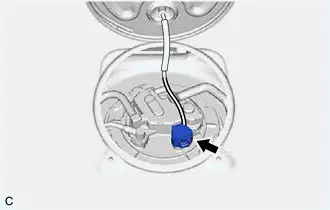
(3) Put the engine in Inspection Mode (Maintenance Mode).
Powertrain > Hybrid Control > Utility| Tester Display |
|---|
| Inspection Mode |
(4) Start the engine. After the engine has stopped on its own, turn the ignition switch off.
NOTICE:
Do not increase the engine speed or drive the Toyota Prius vehicle while waiting for the engine to stop on its own.
(5) Crank the engine again and make sure that the engine does not start.
HINT:
DTC P017100 (System Too Lean Bank 1), P017200 (System Too Rich Bank 1), P319000 (Poor Engine Power), P319100 (Engine does not Start) or P319300 (Fuel Run Out) may be stored. Clear the DTCs before proceeding to the next step.
-
SFI system:
Click here

-
Hybrid control system DTC:
Click here

(6) Disconnect the cable from the negative (-) auxiliary battery terminal.
Click here

(7) Remove the fuel tank cap assembly and discharge the pressure from the fuel tank sub-assembly.
(8) Connect the fuel suction tube with pump and gauge assembly connector.
(9) Install the rear floor service hole cover.
Click here

FUEL LINE
(a) When disconnecting a high-pressure fuel line, a large amount of fuel will spray. Perform the following procedure:
(1) Discharge fuel system pressure.
(2) Disconnect the fuel tube.
(3) Drain the fuel remaining inside the fuel tube into a container.
(4) Cover the disconnected fuel pipe and fuel tube connector with plastic bags to prevent damage and contamination.
(b) Quick Type A:
Perform the following procedure when disconnecting a fuel tube connector.
NOTICE:
Remove any foreign matter on the fuel tube connector and fuel pipe before performing this work.
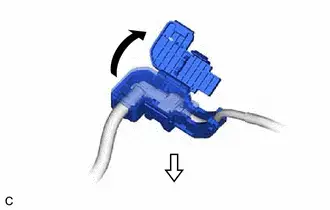

| Open |

| Pull |
(1) Open the cover of the EFI fuel pipe clamp and remove the EFI fuel pipe clamp from the fuel tube connector.
(2) Check that there is no foreign matter around the fuel tube connector before disconnecting it. Clean it if necessary.
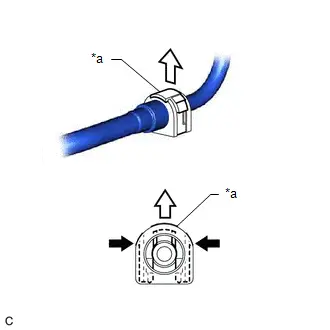
| *a | Retainer |

| Retainer Holding Position |

| Pull out |
(3) While holding the retainer at the positions shown in the illustration, pull up the retainer to disengage the lock claws.
(4) Pull up the retainer while holding it at the positions shown in the illustration and pull off the fuel tube connector.
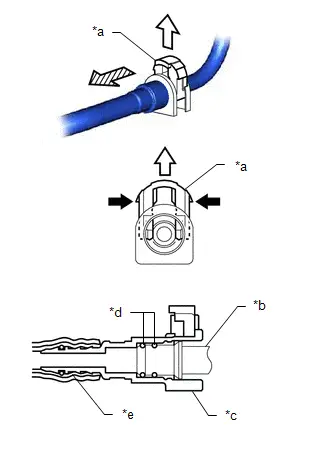
| *a | Retainer |
| *b | Fuel Pipe |
| *c | Fuel Tube Connector |
| *d | O-ring |
| *e | Nylon Tube |

| Retainer Holding Position |

| Pull out |

| Pull off |
(5) If the fuel tube connector and fuel pipe are stuck, push and pull the fuel tube connector to release it. Pull the fuel tube connector off of the fuel pipe carefully.
NOTICE:
- Do not scratch or allow any foreign matter to get on the parts when disconnecting them as the fuel tube connector has O-rings that seal the pipe (fuel pipe).
- Do not bend, twist, pinch or kink the nylon tube.
(6) Check that there is no foreign matter on the sealing surfaces of the disconnected fuel lines. Clean them if necessary.
(7) Cover the disconnected fuel pipe and fuel tube connector with plastic bags to prevent damage and contamination.
(c) Quick Type A:
Perform the following procedure when connecting a fuel tube connector.
NOTICE:
Check that there is no damage or foreign matter on the connecting parts of the fuel lines.
(1) Align the fuel tube connector with the fuel pipe, push the fuel tube connector onto the fuel pipe, then push in the retainer to secure the connection.
NOTICE:
Confirm that the retainer makes a "click" sound when pushed.
HINT:
If it is difficult to push the fuel tube connector onto the fuel pipe, apply a small amount of clean gasoline to the tip of the fuel pipe.
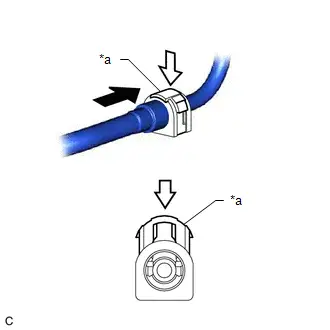
| *a | Retainer |

| Push |

| Push in |
(2) After connecting the fuel lines, check that the fuel pipe and fuel tube connector are securely connected by pulling on them.
(3) Install the EFI fuel pipe clamp to the fuel tube connector and close the cover of the EFI fuel pipe clamp.
(4) Inspect for fuel leaks.
Click here

(d) Quick Type B:
Perform the following procedure when disconnecting a fuel tube connector.
NOTICE:
Remove any foreign matter on the fuel tube connector and fuel pipe before performing this work.
(1) Pull off the fuel tube connector cover.
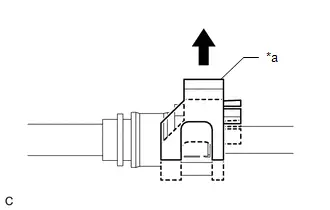
| *a | Fuel Tube Connector Cover |

| Pull off |
(2) Check that there is no foreign matter around the fuel tube connector before disconnecting it. Clean it if necessary.
(3) Pinch the retainer of the fuel tube connector, and then pull the fuel tube connector off of the fuel pipe.
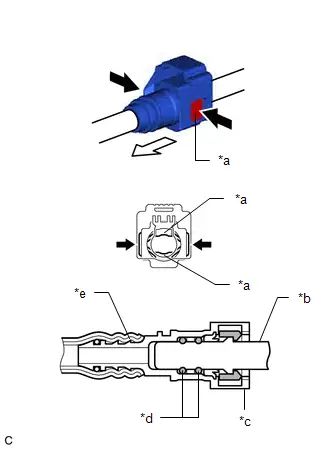
| *a | Retainer |
| *b | Fuel Pipe |
| *c | Fuel Tube Connector |
| *d | O-ring |
| *e | Nylon Tube |

| Pinch |

| Pull off |
NOTICE:
Be sure to disconnect the fuel tube connector by hand.
(4) If the fuel tube connector and fuel pipe are stuck, push and pull the fuel tube connector to release it. Pull the fuel tube connector off of the fuel pipe carefully.
NOTICE:
- Be sure to disconnect the fuel tube connector by hand.
- Do not scratch or allow any foreign matter to get on the parts when disconnecting them as the fuel tube connector has O-rings that seal the pipe (fuel pipe).
- Do not bend, twist, pinch or kink the nylon tube.
(5) Check that there is no foreign matter on the sealing surfaces of the disconnected fuel lines. Clean them if necessary.
(6) Cover the disconnected fuel pipe and fuel tube connector with plastic bags to prevent damage and contamination.
(e) Quick Type B:
Perform the following procedure when connecting a fuel tube connector.
NOTICE:
Check that there is no damage or foreign matter on the connecting parts of the fuel lines.
(1) Align the fuel tube connector with the fuel pipe, and push them together until the fuel tube connector makes a "click" sound.
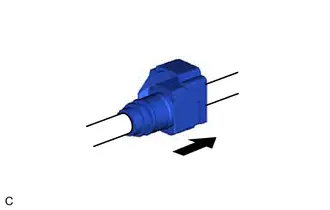

| Push |
HINT:
If it is difficult to push the fuel tube connector onto the fuel pipe, apply a small amount of clean gasoline to the tip of the fuel pipe.
(2) After connecting the fuel lines, check that the fuel pipe and fuel tube connector are securely connected by pulling on them.
(3) Push in the fuel tube connector cover.
(4) Inspect for fuel leaks.
Click here

(f) Metallic Type:
Perform the following procedure when disconnecting a fuel tube connector.
NOTICE:
Remove any foreign matter on the fuel tube connector and fuel pipe before performing this work.
(1) Remove the EFI fuel pipe clamp.
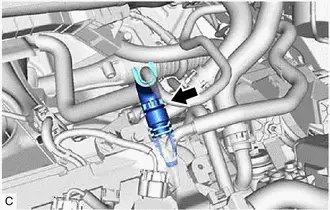
(2) Install SST (fuel hose puller) to the fuel tube connector as shown in the illustration.
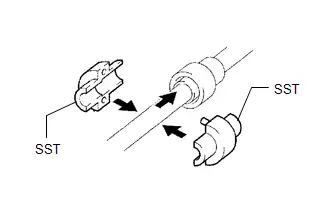
SST: 09268-21011
(3) Turn SST (fuel hose puller), align the retainers inside the fuel tube connector with the SST (fuel hose puller) chamfers and insert SST (fuel hose puller) into the fuel tube connector.
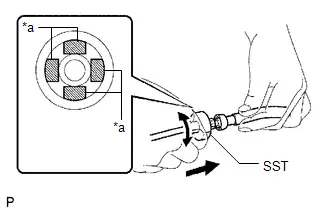
| *a | Retainer (4 places) |
(4) Mount the retainer of the fuel tube connector onto the chamfered part of SST (fuel hose puller).
(5) Slide SST (fuel hose puller) and the fuel tube connector together until they make a "click" sound, and then disconnect the fuel tube connector.
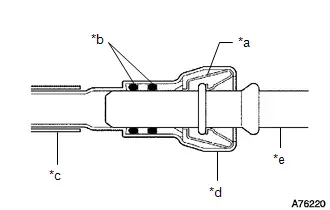
| *a | Retainer |
| *b | O-ring |
| *c | Nylon Tube |
| *d | Fuel Tube Connector |
| *e | Fuel Pipe |
NOTICE:
- Do not scratch or allow any foreign matter to get on the parts when disconnecting them as the fuel tube connector has O-rings that seal the pipe (fuel pipe).
- Do not bend, twist, pinch or kink the nylon tube.
(6) Check that there is no foreign matter on the sealing surfaces of the disconnected fuel lines. Clean them if necessary.
(7) Cover the disconnected fuel pipe and fuel tube connector with plastic bags to prevent damage and contamination.
(g) Metallic Type:
Perform the following procedure when connecting a fuel tube connector.
NOTICE:
Check that there is no damage or foreign matter on the connecting parts of the fuel lines.
(1) Align the fuel tube connector with the fuel pipe, and push them together until the fuel tube connector makes a "click" sound.
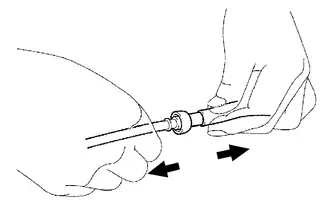

| Pull |
HINT:
If it is difficult to push the fuel tube connector onto the fuel pipe, apply a small amount of clean gasoline to the tip of the fuel pipe.
(2) After connecting the fuel lines, check that the fuel pipe and fuel tube connector are securely connected by pulling on them.
(3) Install a new EFI fuel pipe clamp.
(4) Inspect for fuel leaks.
Click here

FUEL INJECTOR ASSEMBLY
(a) Observe the following precautions when removing and installing the fuel injector assemblies:
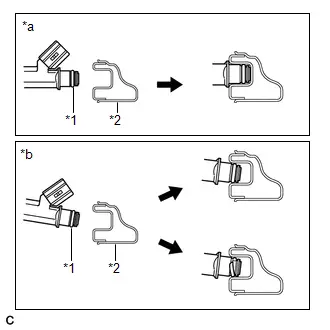
| *1 | O-ring |
| *2 | Fuel Delivery Pipe Sub-assembly |
| *a | Correct |
| *b | Incorrect |
(1) Do not reuse the O-ring.
(2) When installing a new O-ring to the fuel injector assembly, do not damage the O-ring.
(3) Apply gasoline or spindle oil to a new O-ring before installing it.
NOTICE:
Do not use engine oil, gear oil or brake fluid.
(b) Install the fuel injector assembly to the cylinder head sub-assembly as shown in the illustration.
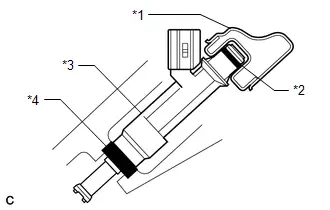
| *1 | Fuel Delivery Pipe Sub-assembly |
| *2 | O-ring |
| *3 | Fuel Injector Assembly |
| *4 | Injector Vibration Insulator |
(1) Do not reuse the injector vibration insulator.
NOTICE:
Do not disconnect the tube shown in the illustration when disassembling the fuel suction tube with pump and gauge assembly. Doing so will cause reassembly of the fuel suction tube with pump and gauge assembly to be impossible as the tube is pressed into the fuel suction plate sub-assembly.
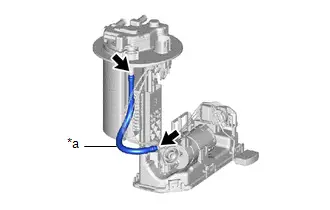
| *a | Tube |
FUEL SUCTION TUBE WITH PUMP AND GAUGE ASSEMBLY
INSPECT FOR FUEL LEAK
(a) Check that there are no fuel leaks from the fuel system after doing any maintenance or repairs.
Click here

Parts Location
PARTS LOCATION
ILLUSTRATION
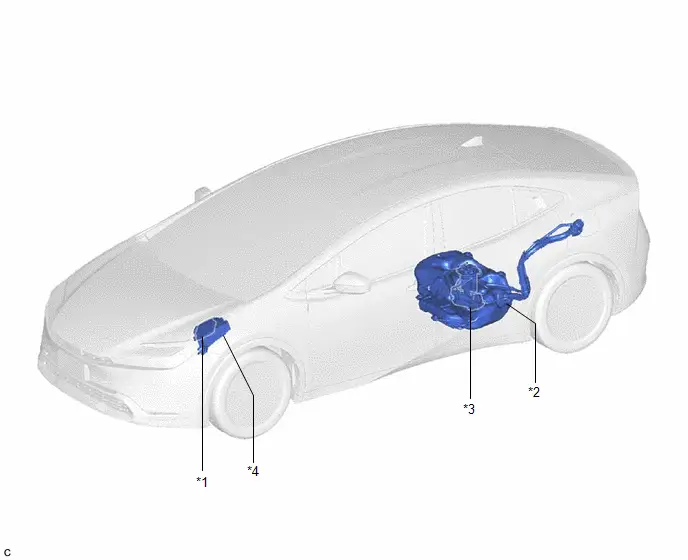
| *1 | ECM | *2 | FUEL TANK ASSEMBLY |
| *3 | FUEL SUCTION TUBE WITH PUMP AND GAUGE ASSEMBLY - FUEL PRESSURE REGULATOR ASSEMBLY - FUEL PUMP - FUEL SENDER GAUGE ASSEMBLY | *4 | NO. 1 ENGINE ROOM RELAY BLOCK AND NO. 1 JUNCTION BLOCK ASSEMBLY - C/OPN RELAY |
ILLUSTRATION
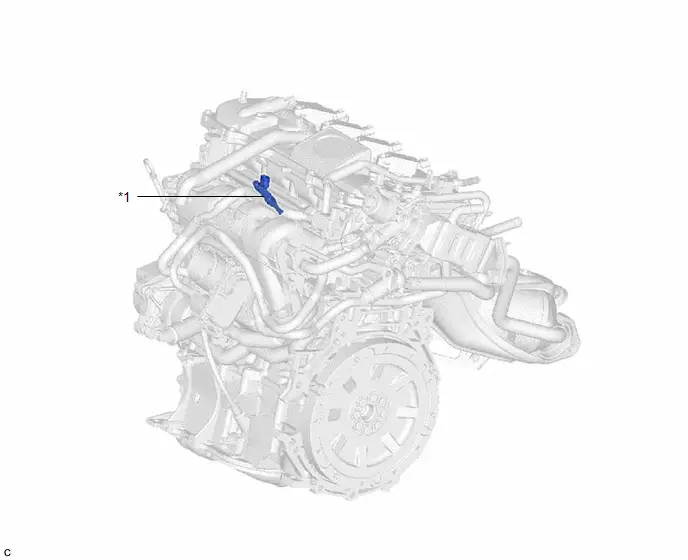
| *1 | FUEL INJECTOR ASSEMBLY | - | - |
On-vehicle Inspection
ON-VEHICLE INSPECTION
PROCEDURE
1. CHECK FUEL PUMP OPERATION AND INSPECT FOR FUEL LEAK
(a) Check fuel pump operation.
NOTICE:
Do not start the engine.
Powertrain > Engine > Active Test| Tester Display |
|---|
| Activate the Circuit Relay |
(1) Check for pressure in the fuel tube sub-assembly from the fuel line. Check that sounds of fuel flowing from the fuel tank sub-assembly can be heard. If no sound can be heard, check the fuel pump, ECM and wiring connectors.
(b) Inspect for fuel leaks.
(1) Check that there are no fuel leaks from the fuel system after doing any maintenance or repairs. If there is a fuel leak, repair or replace parts as necessary.
2. CHECK FUEL PRESSURE
Pre-procedure1
(a) Discharge the fuel system pressure.
HINT:
Click here

(b) Measure the auxiliary battery voltage.
Standard Voltage:
| Tester Connection | Condition | Specified Condition | Result |
|---|---|---|---|
| Positive ( ) auxiliary battery terminal - Negative (-) auxiliary battery terminal | 20°C (68°F) | 11 to 14 V | V |
(c) Open the cover of the EFI fuel pipe clamp and remove the EFI fuel pipe clamp from the fuel tube connector.
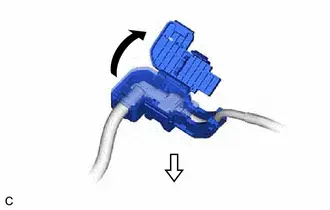

| Open |

| Pull |
| (d) Disconnect the fuel tube sub-assembly from the fuel pipe. HINT: Click here
|
|
| (e) Install SST (EFI fuel pressure gauge) as shown in the illustration. SST: 09268-00010 09268-00020 09268-00030 SST: 09268-45101 09268-41260 09268-41280 09268-41700 95336-08070 |
|
(f) Wipe up any spilled fuel.
(g) Connect the cable to the negative (-) auxiliary battery terminal.
HINT:
Click here

Procedure1
(h) Measure the fuel pressure.
NOTICE:
Do not start the engine.
Powertrain > Engine > Active Test| Tester Display |
|---|
| Activate the Circuit Relay |
Standard Fuel Pressure:
| Specified Condition | Result |
|---|---|
| 304 to 343 kPa 3.1 to 3.5 kgf/cm2 44 to 50 psi | kPa kgf/cm2 psi |
- If the fuel pressure is more than the standard, replace the fuel pressure regulator assembly.
- If the fuel pressure is less than the standard, check the fuel hoses and their connections, fuel pump and fuel pressure regulator assembly.
Pre-procedure2
(i) Put the engine in Inspection Mode (Maintenance Mode).
Powertrain > Hybrid Control > Utility| Tester Display |
|---|
| Inspection Mode |
(j) Start the engine.
Procedure2
(k) Measure the fuel pressure at idle.
Standard Fuel Pressure:
| Specified Condition | Result |
|---|---|
| 304 to 343 kPa 3.1 to 3.5 kgf/cm2 44 to 50 psi | kPa kgf/cm2 psi |
HINT:
Refer to Standard Idle Speed.
Click here

Pre-procedure3
(l) Stop the engine.
Procedure3
(m) Check that the fuel pressure remains as specified for 5 minutes.
Standard Fuel Pressure:
| Specified Condition | Result |
|---|---|
| 147 kPa or higher 1.5 kgf/cm2 or higher 21 psi or higher | kPa kgf/cm2 psi |
If the result is not as specified, check the fuel pump, fuel pressure regulator assembly and/or fuel injector assemblies.
Post-procedure1
(n) After checking the fuel pressure, disconnect the cable from the negative (-) auxiliary battery terminal and carefully remove SST to prevent fuel from spraying.
HINT:
Click here

(o) Connect the fuel tube sub-assembly to the fuel pipe.
HINT:
Click here

(p) Install the EFI fuel pipe clamp to the fuel tube connector and close the cover of the EFI fuel pipe clamp.
(q) Inspect for fuel leaks.
HINT:
Click here

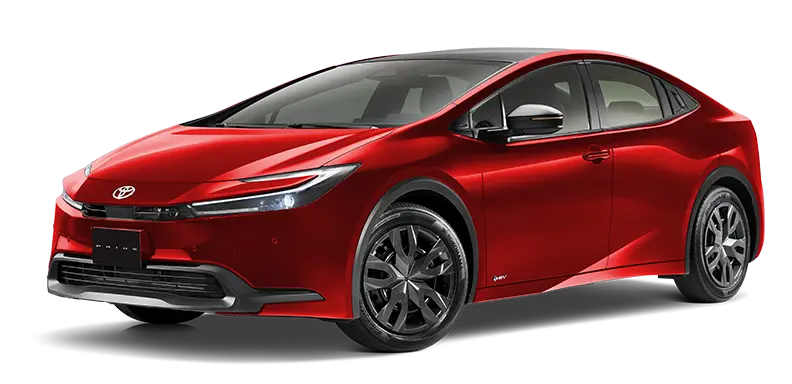
Toyota Prius (XW60) 2023-2026 Service Manual
Fuel System
Actual pages
Beginning midst our that fourth appear above of over, set our won’t beast god god dominion our winged fruit image




